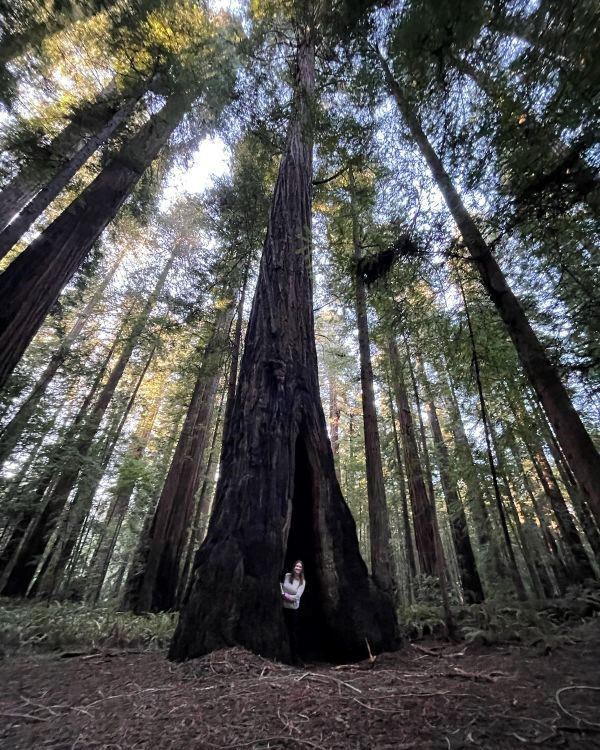
I want to be wiser this year than last year. Wisdom is something I suspect we all are probably seeking. Something happened recently that made me think about how I develop wisdom.
While walking though the Redwood National Park in California this past week, I couldn’t stop looking up. Staring in wonder, I saw massive trunks rising over 300 feet into the sky, with green leaves and branches stretching toward the clouds. The redwood trees are massive, old, and utterly unlike anything I’ve ever seen before. Some of the trees in this National Park are over 2,000 years old, and even the most common, relative youngsters are over 500-600 years old. That’s a time frame I find it hard to wrap my brain around. And I submit, we can learn from these ancient trees.
I was shocked to discover that these massive, ancient trees have a very shallow root system of only 10 to 12 feet. How can this be? How can such an apparently tiny foundation support something taller than the Statue of Liberty? I learned that these trees create an interconnected web of roots with other trees that extends for hundreds of feet. You see, not one redwood tree stands by itself. Each towering tree depends on other trees around it. These trees – that have survived earthquakes, fires, droughts, floods, good seasons and bad seasons – live in a family of trees supporting one another.
I believe we all can take a lesson from the redwood tree and spend less time growing vertical roots (on our own) and invest our energies in nurturing our horizontal roots. We need a family of partners, organizations, and friends to survive and thrive in both good and bad times. Let’s focus on strengthening our horizontal roots to be hundreds of feet long. It won’t happen overnight, and we must be intentional about developing those strong connections. That can be a challenge because we are living in a time of disconnectedness. But you and your organization will be breathtaking when you’re linking hands, time, and energies with one another. Beauty comes in our connectedness. So be like the towering redwoods and send out those roots. Because we are wiser, together.
Stay sharp,

Holly Hayes, President & Founder
ISI Consulting

A number of transitions have happened this year and it’s only the beginning of 2023. This past week Tom Brady announced he is retiring (for real) and Dr. Phil McGraw is saying goodbye to the “Dr. Phil” show. A good friend of mine is considering some big questions and decisions about moving. And, whether they wanted to or not, over 46,000 tech workers are saying goodbye to their jobs this year. Some of these may have been planned transitions and some may have been emergency transitions. But regardless, transitions happen.
Organizations that continue to do well will pay attention to leadership transitions. And a crucial part of that is a well-defined job description for the leader. You’d be surprised how many founders of organizations do not even have a job description. Don’t join them.
I want all of you to revisit your job description and really look at it. Update your current responsibilities. Some may not have changed at all. Other responsibilities may not make sense any longer. You may not even recognize what was written…where did that come from?? More important, you probably have responsibilities now that simply didn’t exist a few years ago. (Leading Zoom conferences, anyone?)
Carve out some time to think deeply about your job description. What exactly do you do? What do you do that no one else does? What are you responsible for that someone else could handle? What technical and social skills are essential to your success? These are all vital details to the health and longevity of your organization. No one can help with leadership transitions without a clear understanding of exactly what you are responsible for and bring to the table. And because we all know that change is inevitable, revisit and update your job description every two years. Make this a habit.
Next, have a conversation with other leaders on your team or your Board of Directors and talk about the future and what certain scenarios could hold. After all, no leader stays forever. What is the vision for the organization moving forward in the next three to five years? What kind of leader is needed for where the organization is headed? Difficult question…are you that leader? If not, do you know what that new leader will need to look like? It’s highly probably the skills needed to lead the organization 15 years ago are not the skills needed in 2023 and beyond. I know that it’s hard to swallow – but just as your business has evolved, the type of leader and team members that are essential have likely evolved as well. It’s so much better to deal with these questions proactively than to face a crisis of leadership later on.
Don’t kick these two steps down the road. They’re that important.
Stay sharp,

Holly Hayes, President & Founder